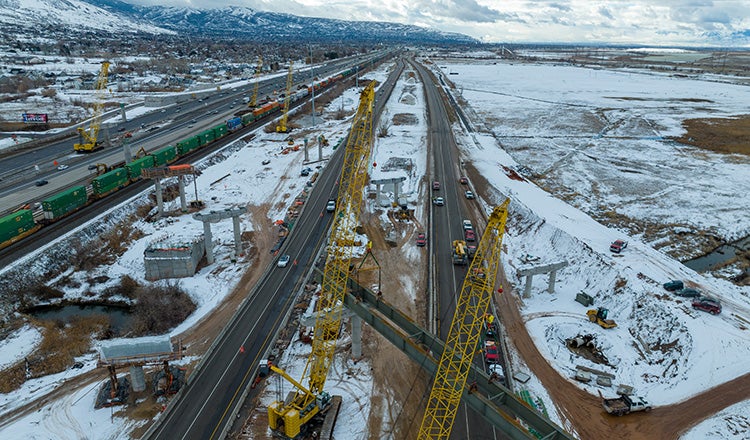West Davis Corridor Program Management

West Davis Corridor Program Management
16-Mile Greenfield Highway Design-Build Stays on Track to Open On Budget, Ahead of Schedule
New housing and developments are leading to rapid growth in western Davis County, Utah, north of Salt Lake City. This has created a strain on the capacity of Interstate 15, the major north-south highway through the region. The West Davis Corridor, a new 16-mile, four-lane divided highway, will reduce congestion and anticipate the needs of ongoing growth.
The greenfield highway travels through six cities in Davis County, extending northwest from Glovers Lane in Farmington through Centreville, Kaysville, Layton, Syracuse and ending in West Point. It includes five new interchanges, 34 structures of multiple types, more than 25 third-party utility relocations, a major system interchange with I-15 and Legacy Parkway and more than 20 miles of new trail and trail connections.
As program manager for the Utah Department of Transportation, HDR provided preliminary engineering, conducted risk workshops and developed the estimate for the project. Our team prepared the design-build procurement documents, and we participated in the selection of a design-builder. After selection, our team managed the design-build process through all phases, from preliminary design through construction and closeout.
Foundation Built on Environmental Rigor
HDR’s contributions to the project began early. Our team began environmental work on the corridor in 2010, evaluating 51 alternatives for their potential impacts. We continued to assist UDOT throughout the seven-year journey to a signed record of decision, preparing the draft and final environmental impact statements and assisting with the development of a 1,100-acre wetland and wildlife mitigation site.
As the project development continued, we helped UDOT make major decisions about the $750 million project’s structure, helping them determine the right scope based on available funding, the best delivery method to maximize the scope and whether phasing would be required.

Our risk assessment and value engineering experts led several risk workshops to identify the top risks and opportunities for mitigation strategies that were incorporated into a comprehensive risk matrix. The risk matrix was then used to develop the requirements in the request for proposal and to highlight potential areas for innovation from design builders. For example, the Layton Canal, used to deliver irrigation water to local farmers, was identified as a top risk, so the team developed plans for an early relocation package and hired a contractor to relocate the canal ahead of selecting a design-builder.
We also fostered innovation by conducting early informational meetings with each of the interested design-build teams. These meetings allowed us to gather feedback and provide early information packages prior to releasing the draft RFP. We developed a procurement schedule that allowed enough time for the design-builders to prepare alternative technical concepts that maximized project innovation. As a result, we received more than 140 ATCs, ultimately resulting in the winning bid being $60 million less than the engineer’s estimate.
Strong Relationships Lead to Success
After a design-build team was selected, our team co-located with UDOT and the design-builder to promote effective communication and coordination for project planning, procurement, delivery and administration. As program manager, we oversaw project schedule and budget throughout the life of the project. This included our development of powerful project controls tools such as a comprehensive and collaborative dashboard for tracking design, construction, and administrative submittals. The dashboard created clear, concise data and further provided value to the contractor by keeping them up to date on all relevant information. During contract administration, the data was used for change order evaluation, contributing to the project coming in within budget.
Throughout the project, we implemented a straightforward and functional design oversight process. The team was able to perform over 2,100 reviews on time or early, allowing the design-builder to meet their schedule milestones, despite the project beginning just as the global pandemic started. Because the project was awarded during the pandemic, there were material and labor shortages, supply chain issues, and rising inflation that could have impacted the delivery. Partnering with UDOT, we worked with the contractor to procure long lead items including girders, concrete, and retaining wall panels to make sure there was no delay to the project schedule.
Ultimately, our strong relationships with the design-builder helped to effectively administer the contract within the available funding. And the new highway opened to traffic months earlier than the original estimate of summer 2024. The community celebrated the new highway's grand opening on January 6, 2024. More than 2,500 people turned out for a 2-mile fun run on the new trail system, as well as hot chocolate and treats for residents.














